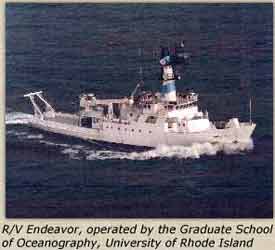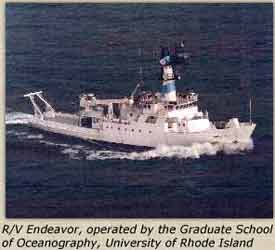Volcano explorations will be broadcast live June 3-8 by Immersion Presents
 NARRAGANSETT, R.I. — May 10, 2006 — A team of scientists from the University of Rhode Island and the Institute for Exploration (IFE) headed by National Geographic Explorer-in-Residence Robert Ballard will lead an expedition this month to explore the archaeology and geology of the Aegean and Black seas using advanced deep-sea technology.
NARRAGANSETT, R.I. — May 10, 2006 — A team of scientists from the University of Rhode Island and the Institute for Exploration (IFE) headed by National Geographic Explorer-in-Residence Robert Ballard will lead an expedition this month to explore the archaeology and geology of the Aegean and Black seas using advanced deep-sea technology.
The 2006 expedition is divided into three segments, each with unique research goals. The primary focus of the expedition is to study the seafloor around the Greek island of Thera (also known as Santorini), where a massive volcanic eruption occurred around 1600 B.C. The eruption of the volcano, also called Thera, was the second largest in human history and caused the collapse of the island’s central portion, forming a massive underwater caldera, or crater. For the first time, the caldera will be examined using remotely operated vehicles (ROVs), including IFE’s Hercules, which is equipped with a high-definition color video camera, temperature sensors, and manipulator arms controlled by scientists onboard the ship.
Immersion Presents, an after-school program founded by Ballard in 2002, will broadcast four live shows a day from the volcano’s research and exploration site to audiences at participating aquariums, schools, universities, science centers and Boys & Girls Clubs of America.
By examining the various layers of volcanic deposits on the seafloor, scientists led by URI professors Haraldur Sigurdsson and Steven Carey, and joined by a team from the Hellenic Center for Marine Research, hope to better understand the volcanic processes that took place. The research will potentially shed light on the role this natural disaster played on the disappearance of the Minoan people around the time of the eruption.
During the Black Sea leg of the expedition, led by Ballard and URI marine scientist Dwight Coleman, the team will build upon previous years’ surveys in which well-preserved ancient shipwrecks were located and documented. This part of the expedition is being undertaken in collaboration with Serhiy Voronov with the Ukraine Department of Underwater Heritage.
Past IFE and Ballard expeditions to the Black Sea helped prove the theory that wood ships could remain intact in the oxygen-deprived waters at the bottom of the Black Sea. Due to the lack of oxygen, the sea’s depths are devoid of life, including wood-eating organisms, thus serving as a giant preservation tank for history’s relics.
This year’s work will focus on two areas south of the Crimean Peninsula in the northern Black Sea. The aim of the 2006 survey is to use side scan sonar technology and ROVs to locate, identify and document archaeological sites that can provide more information on patterns of trade connected to the ancient Greek colony of Chersonesos, both within the Black Sea and out to the Aegean and Mediterranean.
During the expedition, scientists will also conduct a geophysical and archaeological survey in the international waters of the Sea of Crete, in the southern Aegean. Led by Ballard with URI professor Mary Hollinshead and graduate student Katherine Croff, a National Geographic Emerging Explorer, this effort will attempt to establish protocols for deep water archaeology surveys using state of the art deep water robotic technology specifically designed for this purpose. The goal is to map the region and ultimately understand the regions’ role as a crossroads of maritime activity.
Scientific operations began on April 26 aboard the URI research vessel Endeavor and continue through June 18 at various locations in the Sea of Crete and the Black Sea. The expedition is funded by the National Science Foundation, the National Oceanic and Atmospheric Administration’s Office of Ocean Exploration, The Rhode Island Endeavor Project, and the National Geographic Society.
Information on the expedition can be found at: immersionpresents.org, oceanexplorer.noaa.gov, and uri.edu/endeavor/thera.
The public is invited to view the live Immersion Presents broadcasts from the ship at 10 a.m., 11 a.m., noon and 1 p.m. June 3-8 at URI’s Bay Campus and at Mystic Aquarium. For more information about the broadcasts call URI’s Office of Marine Programs at 401-874-6211 or Mystic Aquarium at 860-572-5955.

